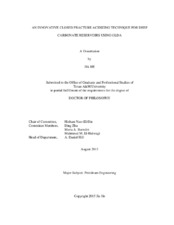| dc.description.abstract | The closed fracture acidizing (CFA) technique is designed to overcome inadequate conductivity development in traditional acid fracturing treatments. However, achieving adequate fracture length is challenging due to the fast acid spending rates and the high corrosion rate to well tubular, especially at high temperatures. This study developed a new closed fracture acidizing (CFA) technique using glutamic acid-N,N-diacetic acid (GLDA) to overcome the limitations of conventional acid fracturing systems and achieve significant length and final fracture conductivity.
In this study, a tensile fracture was created across a low permeability Indiana limestone core of 6 in. in length and 1.5 in. in diameter, using an Instron electric compression test machine. The rough fracture surfaces created were scanned using a profilometer to characterize the etched fracture faces before and after the CFA tests. CFA tests were then conducted using a specially designed coreflood setup with the injection of 20 wt% GLDA and 15 wt% HCl at various temperature conditions. CT scans were used to characterize the grooves or channels developed in the CFA tests. The concentrations of the dissolved calcium ions were measured using Inductively Coupled Plasma–Optical Emission Spectroscopy (ICP-OES), and the effluent samples were titrated to determine the acid concentration.
Results show that closed fractures substantially increased the core permeability under low closure stress, with limited increase under high closure stress (>1,500 psi). Surface topography of natural tensile fractures was highly correlated with initial permeability of tensile fractures and had little correlation with the changing rate of fracture permeability with closure stress; while rock embedment strength was found to be mostly associated with permeability change. 20 wt% GLDA was effective in creating a sufficient amount of flow channels to obtain substantial fracture conductivity at various closure stress conditions. Rock embedment strength measurements showed that 15% HCl tends to weaken the rock embedment strength by more than 20%, while 20 wt% GLDA weakens the rock embedment strengthen by no more than 13% on average. Under all circumstances, most of the HCl was consumed after being injected across the cores, thus resulting in limited fracture length in field conditions. | en |


